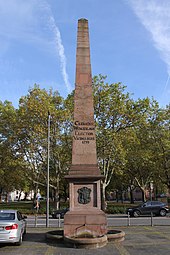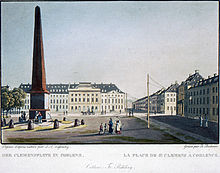Clemensbrunnen (Koblenz)
The Clemensbrunnen is a fountain in the old town of Koblenz . The fountain, built in 1791, originally stood on Clemensplatz and was connected to the first electoral water pipe . Since 1970 he has been standing in front of the theater on Deinhardplatz . It got its name from its builder, the last Trier Elector Clemens Wenzeslaus of Saxony .
history
The first aqueduct from Metternich was completed in 1786 and initially only supplied the newly built Electoral Palace with fresh spring water . Then the builder of the castle and water pipe, the Trier Elector Clemens Wenzeslaus of Saxony , had the first public fountain built on Clemensplatz in 1791. The Clemensbrunnen named after him was inaugurated on the name of the elector on November 23, 1791. It is the oldest of a total of three public fountains that were fed by the first functioning water pipe in Koblenz.
The Clemensbrunnen was moved to its current location in front of the theater in 1970. It is only about 75 meters west of its original location. The four semicircular fountain shells and the electoral coat of arms , which were lost in the meantime, were reconstructed . After that, Clemensplatz was used as a parking lot and finally converted into a park for the 2011 Federal Horticultural Show .
construction
The nine meter high Clemensbrunnen consists of a square base above a stepped high pedestal made of red sandstone and the obelisk standing on it . The following Latin inscription can be read on two sides of the obelisk: "Clemens Wenceslaus Elector Vicinis suis 1791" (German: Clemens Wenzeslaus, Elector, his neighbor 1791). On the side of the pedestal facing the theater is the coat of arms of the elector. Four stone, semicircular bowls are attached to the base in which the water is collected.
Monument protection
The Clemensbrunnen is a protected cultural monument according to the Monument Protection Act (DSchG) and entered in the list of monuments of the state of Rhineland-Palatinate . It is in Koblenz's old town on Deinhardplatz .
The Clemensbrunnen has been part of the Upper Middle Rhine Valley UNESCO World Heritage Site since 2002 .
See also
literature
- Energieversorgung Mittelrhein GmbH (ed.): History of the city of Koblenz . Overall editing: Ingrid Bátori in conjunction with Dieter Kerber and Hans Josef Schmidt
- Volume 1: From the beginning to the end of the electoral era . Theiss, Stuttgart 1992, ISBN 3-8062-0876-X .
- Volume 2: From the French city to the present . Theiss, Stuttgart 1993, ISBN 3-8062-1036-5 .
- Herbert Dellwing (editor): Cultural monuments in Rhineland-Palatinate. Monument topography Federal Republic of Germany. Volume 3.2: City of Koblenz. Downtown. Werner, Worms 2004, ISBN 3-88462-198-X , p. 112ff.
- Wolfgang Schütz: Koblenz heads. People from the city's history - namesake for streets and squares. 2. revised u. exp. Edition. Publishing house for advertising papers , Mülheim-Kärlich 2005, OCLC 712343799 , p. 455ff.
Web links
- Clemensbrunnen in: regionalgeschichte.net
Individual evidence
- ↑ General Directorate for Cultural Heritage Rhineland-Palatinate (ed.): Informational directory of cultural monuments - district-free city of Koblenz (PDF; 1.5 MB), Koblenz 2013.
Coordinates: 50 ° 21 ′ 29.2 " N , 7 ° 35 ′ 59.5" E


